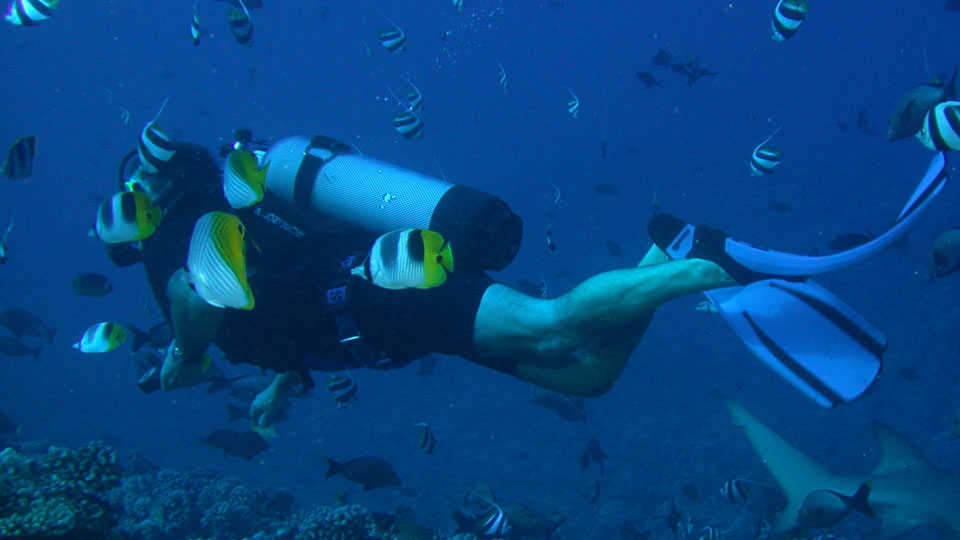In this activity, students will:
- learn how organisms float, sink, or hover in water.
- construct a neutrally buoyant scuba diver.

"Diver and Lemonshark" © 2004 Hpm~commonswiki
What helps SCUBA divers, sharks, fish, and other marine organisms stay in the water column? In this hands-on investigation, students will explore the concepts of buoyancy and mass to create a device to help an action figure stay neutrally buoyant, just like a scuba diver.
In this activity, students will:
Scuba diving is an excellent hobby for underwater naturalists. Along the California coast, scuba divers can see kelp forests, sea otters, many species of fish, sea lions, and a variety of invertebrates such as octopuses, crabs and urchins. With the aid of specialized equipment, divers can prolong their visit below the surface for a lot longer than they can hold their breath! Expert divers have set records exploring ocean depths of approximately 1000 feet (305 meters), but, most scuba divers swim closer to shore where the water is shallower.
Scuba diving requires training as well as specialized equipment, called SCUBA (Self-Contained Underwater Breathing Apparatus) gear, which includes one or two oxygen tanks strapped to the back of the diver and a regulator that fits into the mouth and controls the flow of air. It is essential for divers to be able to breathe underwater, but they also need to be neutrally buoyant to prevent floating to the surface or sinking to the bottom. What makes divers sink or float depends on a combination of the density of their bodies, the density of the diving equipment they wear, and the density of sea water.
Water has a natural force that pushes up towards the surface. This is called the buoyant force. The buoyant force comes from the pressure exerted on the object by the fluid. Pressure increases as depth increases, so the pressure on the bottom of an object is always greater than the force on the top resulting in a net upward force.
The net upward buoyancy force is equal to the weight of fluid displaced by an object. This force enables an object to float or at least seem lighter. If the weight of an object is less than the weight of the displaced fluid when fully submerged, the object has an average density that is less than the fluid and has a buoyancy that is greater than its own weight which results in the object tending to rise. If the object has exactly the same density as the fluid, then its buoyancy equals its weight and the object will remain submerged in the fluid, but will neither sink nor float. An object with a higher average density than the fluid has less buoyancy than weight and it will sink.
Other forces act on a floating body in the ocean, such as drag (due to the density of the fluid), thrust (if the body pushes the water away), and weight (which pushes the body down toward the ocean floor).
The net weight of a scuba diver can be altered by decreasing or increasing density using air or solid weights. Scuba divers can change their density by adding or releasing air from a buoyancy compensator, or BC, a vest that holds air. Solid weights help the diver to stay underwater by increasing their net weight.
The density of tap water is 1 g/cm³. The water off the coast of Northern California is cold and varies from 50 to 60 degrees Fahrenheit. Cold water can dissolve more salt than warm water. High salinity and low temperatures make the water more dense. Therefore, the physical properties of water off the California coast require divers to wear a thicker wetsuit (to stay warm) and more weights (to add net weight) than they might need to wear when diving in warmer waters in the tropics.
Image: "Diver and Lemonshark" by HPM~commonswiki, licensed and modified under CC BY-SA; originally sourced from https://commons.wikimedia.org/wiki/File:Diver_and_lemonshark.JPG
Scientific & Engineering Practices
Disciplinary Core Ideas
Cross-Cutting Concepts
Related Performance Expectations